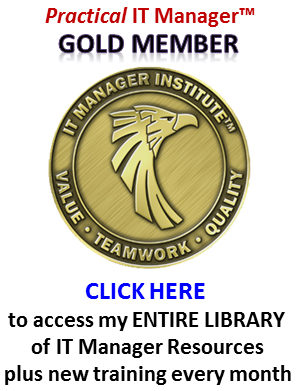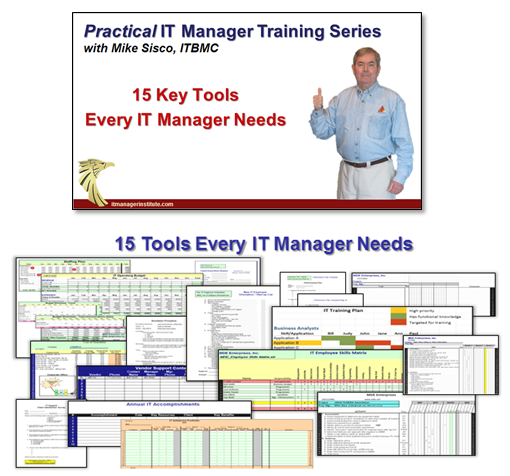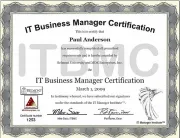 It’s never too late to step back and take a look at your career, where you have come from, where you are, and especially where you want to be in five years.
It’s never too late to step back and take a look at your career, where you have come from, where you are, and especially where you want to be in five years.
I have always had a question that I ask my employees in a career discussion, “What do you want to be when you grow up?”
I still ask myself this question every year and I’m an “old guy”, or “over half a century” as my son puts it. It doesn’t mean that I’m still looking for a career; it just means that I analyze where I am from time to time and whether I am living up to my potential.
That’s a key point: career planning is an ongoing process, not an event.
I have been very fortunate in my career in that I have had many excellent mentors and role models. The years I was with IBM taught me the importance of performance planning and reviews. It also gave me a keen sense of the importance of providing excellent client service and having fun at what you do.
Another company that helped me a lot was HBO & Company, now part of McKesson. I worked with great people and achieved some major career growth at this company. I still have many close friends who are still there.
Being associated with quality people helps mold your management philosophy and character in the right direction. I owe a lot to many that I’ve been associated with throughout my career.
If you have never been part of developing a career plan, now is the time to start. You can use the following steps to develop a plan for yourself or for an employee.
Step 1 – Take an introspective look.
 Before you put a plan together, step back and take a close look at what makes you happy. In other words, what type of work makes you want to “jump out of bed” in the morning and get to your work as quickly as you can every day because you love what you do.
Before you put a plan together, step back and take a close look at what makes you happy. In other words, what type of work makes you want to “jump out of bed” in the morning and get to your work as quickly as you can every day because you love what you do.
Too often, people settle into types of work or roles that are not that interesting or fun for them but they do it “for the money” or for some other reason. Many times a person can get “stuck” in a job that he or she literally hates, , , but will stay in it to avoid making a change.
My sincere belief is that when you find your life’s passion, the money will come. In fact, you may make more than you ever did in an unfulfilling job, , , I’ve seen it happen many times.
Money is not everything, certainly. My Dad never made a lot of money but he was one of the happiest people I know and truly enjoyed his life as anyone that knew him will attest. When you look at yourself, focus in on the type of work or the lifestyle that makes you happy. Loving your work and the people you work with makes life so much more enjoyable.
In coaching others about career planning, I always try to get them to focus on the type of work they like, , , not the position or title. Many employees will say, “I want to be a manager.”, when they do not have the slightest clue about what being a manager really entails. Too many people take jobs because they believe that’s what others expect of them. Career planning is very much about choosing the direction that you want to take in your life, , , it’s about making choices.
Step 2 – “What do you want to be when you grow up?”
To create a career plan, you have to look into the future. It’s hard for some of us to do this; it’s much easier to just sit back and take whatever comes available. You can get ahead that way but it’s similar to floating a canoe down the river without a paddle. I prefer to set a goal, build a plan, and then “go for it”, , , in other words, put a paddle in the water and row to the exact destination you want to go to.
 Another thing that you need to contemplate is that once you determine what it is you really want, you will need to develop a plan to get there. For example, if you are a network administrator today and you believe that you would make a good CIO some day and really want the opportunity to manage an organization, there are many paths that will get you there. There are also paths that will block the entrance to the CIO door.
Another thing that you need to contemplate is that once you determine what it is you really want, you will need to develop a plan to get there. For example, if you are a network administrator today and you believe that you would make a good CIO some day and really want the opportunity to manage an organization, there are many paths that will get you there. There are also paths that will block the entrance to the CIO door.
When you determine the type of work that you really want, talk to someone that’s already doing this type of work. Ask very specific questions to learn all that you can about the nice parts of the work and the issues and problems. Remember, any type of work that you choose has challenges; otherwise, everyone might be doing it.
Be honest with yourself. Visualize what your days will be like and what you have to do to be successful at this type of work. Evaluate honestly with yourself whether you have the initiative and perseverance to do this type of work with real passion. Wanting to be a CIO and liking to deal with the issues that a CIO must deal with are two separate issues. It’s not all glory and the phrase, “It’s lonely at the top.” was coined for a reason.
Determine the type of skills needed to succeed in your future career work. If strong communication skills are needed, but you are shy and more introverted, , , then you have to develop these skills. Not impossible by any stretch, but still a challenge that must be overcome.
Take the time and make the effort to look several years out. Simply looking at the next job is not really creating a career plan. You don’t have to figure it all out today, but if you are truly interested in developing a real career plan, you have to start looking further into the future.
Part of the reason for this is that when you begin to develop your plan, you want to take steps that keep doors open for future positions or roles that lead to your ultimate goal. Just taking the next job that materializes can actually limit or block access to the career work that you want.
The sooner you decide what you want, the easier it will be to develop a realistic plan to get there. And remember, just because you decide on one direction today does not mean that you can’t change it later. You may decide that you want nothing to do with a management role after experiencing your first management responsibility, , , that’s perfectly fine, , , after all, it’s your career.
The best example I can give you was when I was an IBM Systems Engineer (SE) early in my career. My manager convinced me to become a salesman rather than move toward an SE Manager path because he knew that it would develop new skills and open additional doors that would position me for greater management roles in the future.
The bottom line here is that he helped me realize the need to look at two or three positions into the future, not just the next one. I discovered that I didn’t want to be a salesman, but I’m convinced that what I learned as an IBM Marketing Rep helped me in my management career later on.
Step 3 – Create a plan.
To develop a career plan, you need three components:
- Where you are
- Career objective
- Paths to get there
It’s always been easier for me to look at a picture or to take a 20,000-foot view of a situation. You can do the same thing in developing a career plan. Start by drawing yourself a series of three boxes in four rows and describe your current position in the middle box of the bottom row as shown in Figure 1.
 Figure 1
Figure 1
Let’s use an example to illustrate. Assume you are currently a network administrator and that you aspire to become a CIO. This is a bit of an extreme example but will help you visualize what we are discussing.
When you take a close look at the paths that normally lead to the CIO position, you will discover that more CIO’s come from IT managers of the business applications side of IT rather than the infrastructure side. On the other hand, CTO’s tend to come from the infrastructure side.
Several possible paths can be viable paths, but a CIO must be able to relate business issues with technology solutions. Managing business applications development and support tend to prepare you more for that requirement.
Using the template in Figure 1, I fill in typical technical and management positions in the boxes that will prepare one for the CIO position, ultimately getting to what you see in Figure-2. Please note that this is an example; there may be additional steps required to reach a CIO level in your company situation.
 Figure 2
Figure 2
If you know that 70% or more CIO positions are filled from the Business Applications side, it’s logical to pursue the path of the boxes that are filled in. Another route is to follow a vertical path that leads to Manager of Infrastructure and then to Director of Technology. At this position, the possibility of filling a CIO role is doable but possibly more remote. The CTO position is a strong logical next step from the Director of Technology position. From the CTO position, you can position yourself for the CIO role.
Nothing is cast in stone and qualified individuals will always break the norm. The example intends to show that there are many paths that lead to the CIO position but one path usually gets the desired promotion more than the others. The trick is to move into positions that keep your options open.
Career planning is similar to when you started college. Some Freshmen know exactly what they want to be when they finish college and can plan their curriculum exactly. Other Freshmen don’t really know what they want to be so they take a general studies curriculum until it begins to become more clear for them.
Career planning requires you to stop and think about your career and to work out a plan that will work. Planning comes more difficult for some.
If you are developing a plan for yourself, always seek the advice of your manager and others who would know about how to reach your desired goal, , , or who have the experience and can discuss your career options with you.
Not all managers are comfortable in developing a career plan for their employees. Don’t let that prevent you from creating one yourself. What I’ve seen throughout my career is that those who decide what they want and put a plan in motion tend to achieve their objectives.
Go for it !!
 Looks like a real pool, doesn’t it?
Looks like a real pool, doesn’t it? Just a painting on a flat sidewalk surface
Just a painting on a flat sidewalk surface No hole, , , just art that looks very real, , , see them avoid the hole?
No hole, , , just art that looks very real, , , see them avoid the hole?


























